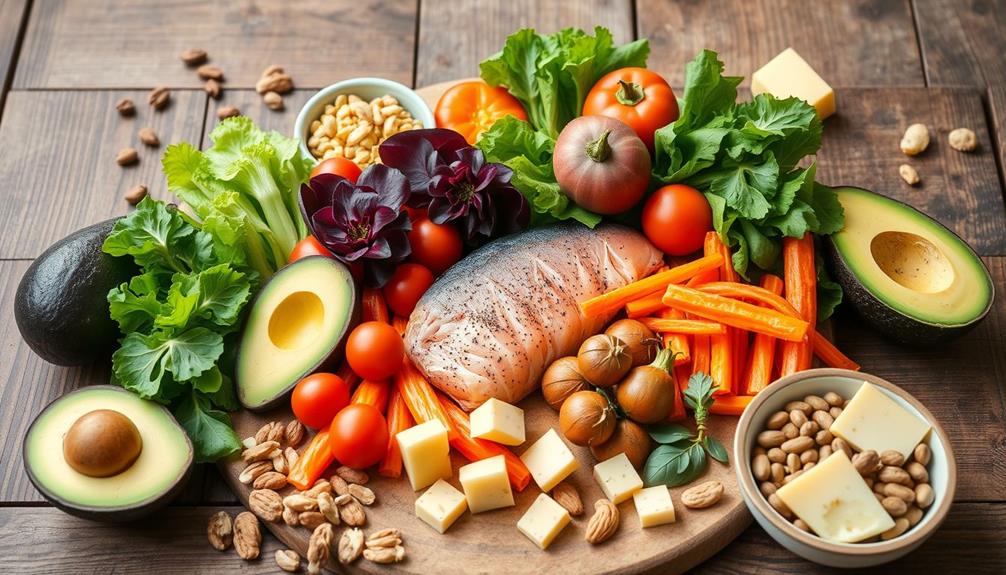The keto diet is a low-carb, high-fat eating plan that shifts your body's primary energy source from glucose to fat, a process known as ketosis. You drastically reduce carbohydrate intake, typically to 20-50 grams per day, while increasing fats to about 70% of your daily calories. This approach helps you burn stored fat for energy, often resulting in quick weight loss. You'll enjoy foods like avocados, nuts, and fatty cuts of meat while avoiding carbs like bread, pasta, and sugar. Curiously, there's much more to discover about the benefits and challenges of this transformative diet. If you’re considering trying the keto diet, it’s important to understand the ketogenic diet basics before diving in. While rapid weight loss is a common benefit, this eating plan can also have potential side effects like the “keto flu,” which can cause fatigue, dizziness, and irritability as your body adjusts to using fat for fuel. It’s essential to consult with a healthcare professional before starting any new diet, especially one as transformative as the keto diet. Understanding the ketogenic diet basics will help you make informed choices and navigate the potential challenges of this high-fat, low-carb eating plan.
Key Takeaways
- The ketogenic diet emphasizes low carbohydrate intake (20-50 grams) and high fat consumption (70-80%) to induce ketosis, a state where fat is used for energy.
- Ketosis occurs when the body shifts from burning glucose to burning fat, providing ketone bodies as an alternative energy source.
- Foods recommended on the keto diet include avocados, fatty meats, low-carb vegetables, and high-fat dairy, while avoiding grains and sugary foods.
- The diet is known for potential weight loss, improved insulin sensitivity, and therapeutic effects for epilepsy, but requires careful management.
- Common side effects include the "keto flu," digestive issues, and low blood sugar symptoms, which usually subside after the initial adaptation phase.
Understanding the Ketogenic Diet

The ketogenic diet, often called keto, focuses on drastically reducing carbohydrate intake and replacing it with fat. This approach typically involves a macronutrient distribution of about 70-80% fat, 15-25% protein, and 5-10% carbohydrates. By minimizing your carbohydrate intake to below 50 grams per day, you can induce a metabolic state known as ketosis, where fat becomes your primary energy source instead of carbs. In ketosis, your body becomes highly efficient at burning fat for energy, which can lead to significant weight loss and other health benefits such as better blood sugar control. A typical keto meal plan includes foods like avocados, fatty fish, meats, eggs, cheese, and low-carb vegetables, while avoiding high-carb foods like grains, sugars, and most fruits. By staying consistent with this diet, many people report increased energy levels and improved mental clarity.
Additionally, incorporating foods rich in antioxidants, such as celery juice, can support overall health during this dietary shift.
When you enter ketosis, your body converts fat into ketone bodies, which can serve as an alternative energy source for your brain. Many people turn to the ketogenic diet for weight loss, and you might notice initial weight loss due to reduced carbohydrate intake and water loss. It's important, though, to be mindful of your nutritional intake since long-term adherence can lead to deficiencies if you're not careful.
Common high-fat foods you can enjoy on this diet include avocados, nuts, seeds, fatty fish, and low-carb vegetables. However, you should avoid sugars, grains, and most fruits.
Alongside weight loss, the ketogenic diet may offer health benefits, including improved insulin sensitivity and better metabolic health markers.
How Ketosis Works

Understanding how ketosis works is essential for anyone aiming to thrive on the ketogenic diet. Ketosis is a metabolic state you achieve by drastically reducing your carbohydrate intake to less than 50 grams per day. When you do this, your body switches from using glucose to burning fat for energy. This shift can be supported by incorporating essential oils like eucalyptus oil to promote respiratory health during your dietary change.
During the change, which typically takes 3 to 4 days of strict carb restriction, your glycogen stores are depleted. As a result, your liver starts converting fatty acids into ketone bodies, which serve as an alternative energy source for your brain and other tissues.
It's important to manage your protein intake, as higher levels can inhibit ketosis. Excess protein can undergo gluconeogenesis, converting back to glucose and potentially preventing your body from fully shifting to using fat for energy.
When you're in ketosis, you'll notice elevated levels of ketones in your bloodstream. You can confirm this through urine or blood tests, which indicate that your body is efficiently utilizing fat for energy. Understanding these processes will help you maximize the benefits of the ketogenic diet.
Food Choices for Keto

When you're following a keto diet, it's essential to choose your foods wisely. Incorporating a variety of low-carb, high-fat options can help keep your meals interesting and satisfying.
Focus on including high-fat options like fatty meats, full-fat dairy, and low-carb veggies while steering clear of grains and sugary snacks.
For more insights on maintaining a balanced approach, consider effective strategies for weight loss.
Planning your meals ahead can make it easier to stick to these guidelines and maintain ketosis.
Foods to Include
To thrive on a ketogenic diet, you'll want to focus on incorporating a variety of high-fat foods that keep your carb intake low. Aim for about 70% of your daily calorie intake from fats. Excellent choices include avocados, nuts, seeds, and healthy oils like olive and coconut oil.
For protein sources, opt for fatty cuts of meat, poultry, fish, and eggs, making sure they constitute roughly 20% of your total calories. Additionally, consider the significance of hydration and how certain foods can support overall health, including those beneficial for gout management.
When it comes to vegetables, prioritize low-carb options such as leafy greens, broccoli, cauliflower, and zucchini. These will help you meet your nutritional needs without exceeding your carb limits.
Dairy products also play a crucial role; stick to high-fat options like cheese and unsweetened yogurt, while avoiding any processed varieties with added sugars.
Although most fruits are off-limits due to high sugar content, you can enjoy small portions of berries, like strawberries and raspberries, in moderation.
Foods to Avoid
Maintaining a ketogenic diet means being mindful of what you eat, particularly when it comes to foods that can derail your progress. To stay in ketosis, you need to avoid certain foods that are high in carbohydrates. Here's a quick reference to help you identify foods to avoid on your keto journey:
| Category | Foods to Avoid |
|---|---|
| Grains | Wheat, rice, pasta, bread |
| Sugary Foods | Soda, fruit juices, candies |
| Fruits | Bananas, apples, oranges |
| Starchy Vegetables | Potatoes, corn, carrots |
| Beans and Legumes | Lentils, chickpeas, kidney beans |
These foods are prohibited due to their high carbohydrate content, which typically exceeds the daily limit of 20-50 grams on a keto diet. Most fruits should be avoided, except for small portions of berries. Starchy vegetables can also disrupt ketosis, so focus on low-carb vegetables like leafy greens. Finally, beans and legumes are restricted as they can interfere with your ketogenic metabolic state. Keeping these guidelines in mind will help you stay on track with your keto lifestyle.
Health Benefits of Keto

The ketogenic diet packs a punch when it comes to health benefits, especially for those looking to shed pounds and improve metabolic health. Research shows that you can achieve significant weight loss on this diet, with participants losing an average of 2 pounds more than those on traditional low-fat diets. This is just the beginning; the ketogenic diet also enhances insulin sensitivity and lowers blood sugar levels, making it particularly beneficial for individuals with type 2 diabetes.
Additionally, adhering to a strict budget while on the keto diet can help manage food costs effectively, allowing for better financial health as well (budgeting tips).
Moreover, the diet has demonstrated remarkable therapeutic effects, especially in children with epilepsy, effectively reducing seizure frequency and improving overall conditions. Emerging studies suggest it may even slow tumor growth in certain cancers, as ketones can serve as an alternative energy source for healthy cells while denying glucose to cancer cells.
Long-term adherence to the ketogenic diet correlates with improved metabolic health markers, including lower triglyceride levels and increased HDL cholesterol. These benefits make the ketogenic diet a promising option for enhancing your overall health and tackling various medical issues.
Whether you're aiming for weight loss or metabolic improvements, the ketogenic diet offers a compelling approach.
Common Side Effects

Steering through the ketogenic diet can come with its share of challenges, especially during the initial shift phase. You might experience what's commonly referred to as the "keto flu," which can include symptoms like fatigue, headache, and nausea.
These symptoms typically last for a few days to weeks as your body adapts to burning fat for fuel instead of carbohydrates. It's significant to recognize that just as inadequate maintenance can lead to decreased efficiency in heat pumps, a lack of proper guidance during the keto changeover can exacerbate these side effects, making it essential to have a solid plan in place for your diet.
This can be especially beneficial for those aiming for optimal comfort in varying weather conditions in their dietary journey.
Additionally, you could notice changes in your urine or breath, often described as fruity-smelling, due to elevated ketone levels. Digestive issues may also arise, with constipation or diarrhea being common, especially from the sudden increase in fat intake and reduced fiber consumption.
Watch out for low blood sugar symptoms as well, such as weakness and irritability, particularly in the first few weeks. While most of these side effects are temporary, they can be uncomfortable.
If you have existing health conditions, it's essential to consult a healthcare professional before starting the ketogenic diet. They can help monitor for any potential complications and guarantee your changeover is as smooth as possible.
Who Should Try Keto

If you're struggling with weight loss or managing type 2 diabetes, the keto diet might be worth considering for its potential benefits.
Additionally, it's often recommended for children with epilepsy and those facing metabolic syndrome.
It's crucial to consult with a healthcare professional for personalized advice, particularly regarding dietary changes that can impact overall health and wellness, including financial planning for healthcare.
However, if you're an elite athlete or focused on building muscle, keto mightn't be the best fit for your goals.
Suitable Candidates for Keto
Many people can benefit from trying the ketogenic diet, especially those who are overweight or struggling with metabolic issues. The keto diet promotes weight loss and improves metabolic health markers, making it a suitable choice for individuals with type 2 diabetes or insulin resistance. By considerably reducing carbohydrate intake, this diet helps lower blood sugar levels and enhance insulin sensitivity.
Here's a quick overview of suitable candidates for the keto diet:
| Candidate Type | Benefits of Keto Diet |
|---|---|
| Overweight or Obese | Promotes considerable weight loss |
| Type 2 Diabetes/Insulin Resistance | Improves blood sugar levels and insulin sensitivity |
| Polycystic Ovary Syndrome (PCOS) | Lowers insulin levels and alleviates symptoms |
Additionally, the ketogenic diet can be beneficial for children with epilepsy, as it has been clinically proven to reduce seizure frequency. However, it is essential to recognize that elite athletes or those focused on muscle gain may not find it suitable due to the low carbohydrate intake impacting performance and recovery. Always consult a healthcare professional before starting any new diet.
Health Considerations and Risks
Considering the potential benefits and challenges of the ketogenic diet, it's vital to evaluate your individual health circumstances before diving in. The ketogenic diet may offer significant benefits for those who are overweight or managing type 2 diabetes, as it can improve metabolic health and blood sugar control.
However, if you have pre-existing health conditions, especially type 1 diabetes or liver issues, it's important to consult healthcare professionals before starting. Additionally, individuals with emotional dysregulation, such as those with Borderline Personality Disorder, may find that drastic dietary changes can exacerbate their symptoms or lead to impulsive eating behaviors.
Long-term adherence to the ketogenic diet can be challenging due to its restrictive carbohydrate intake, which may not be suitable for everyone. For instance, elite athletes or those aiming for significant muscle gain might find their performance hindered by the diet.
You should also be aware that initial weight loss on the keto diet often results from losing water weight rather than fat. Sustainable, long-term results require ongoing dietary management and monitoring.
Before committing to this lifestyle, take the time to assess your readiness and compatibility with the dietary adjustments the ketogenic diet demands.
Managing the Keto Lifestyle

Successfully managing a keto lifestyle requires careful attention to your daily carbohydrate intake, typically aiming for just 20-50 grams. Focus on incorporating high-fat foods that make up about 70% of your daily caloric intake.
Regularly monitoring your environment can also help, as clean air contributes to overall well-being, which can support your dietary goals—consider investing in an air purifier for ideal health air purifier maintenance.
Meal planning is vital; by preparing meals in advance and using keto-friendly recipes, you can avoid cravings and maintain adherence to your diet.
To stay on track, it's important to monitor your food intake. Utilize apps or journals to help you track macronutrient ratios, ensuring you stick to your ketogenic goals.
Don't forget about hydration—drinking enough water and increasing your salt intake can help alleviate the common side effects of the keto flu, like fatigue and headaches, especially during the adaptation phase.
Social situations can pose challenges, but you can navigate them easily. Bring your own keto-friendly snacks to gatherings, or choose restaurants that offer low-carb options to keep you aligned with your dietary goals.
Frequently Asked Questions
What Foods Do You Eat on a Keto Diet?
You'll eat high-fat foods like avocados, fatty meats, and full-fat dairy. Incorporate low-carb vegetables such as leafy greens and cauliflower, while avoiding sugars, grains, and most fruits to maintain your desired carbohydrate levels.
What Are the Basic Rules of a Keto Diet?
Imagine sculpting your body with a chisel; the basic rules of keto shape your diet. You'll limit carbs, prioritize healthy fats, monitor intake, and stay hydrated, ensuring you forge ahead into ketosis effectively.
What Food Is Not Allowed in Keto?
On keto, you'll want to avoid high-sugar foods like candy and soda, grains such as bread and rice, most fruits except berries, starchy veggies like potatoes, and processed snacks due to hidden carbs.
What Is the Basic Idea of Keto Diet?
You greatly cut carbohydrates and increase fat intake to push your body into ketosis. This process shifts your energy source from carbs to fat, promoting weight loss and potentially improving insulin sensitivity and overall health.
Conclusion
In the garden of health, the ketogenic diet can be a vibrant flower, offering unique benefits to those willing to nurture it. As you traverse this path, remember that each choice you make can either sow seeds of liveliness or thorns of discomfort. Embrace the journey, but listen to your body, for it's the wise gardener guiding you. Whether you bloom in the warmth of ketosis or seek other pastures, your health is the true harvest worth cultivating.









